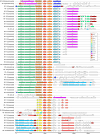Klebsiella pneumoniae carbapenemase variants: the new threat to global public health
- PMID: 37937997
- PMCID: PMC10732083
- DOI: 10.1128/cmr.00008-23
Klebsiella pneumoniae carbapenemase variants: the new threat to global public health
Abstract
Klebsiella pneumoniae carbapenemase (KPC) variants, which refer to the substitution, insertion, or deletion of amino acid sequence compared to wild blaKPC type, have reduced utility of ceftazidime-avibactam (CZA), a pioneer antimicrobial agent in treating carbapenem-resistant Enterobacterales infections. So far, more than 150 blaKPC variants have been reported worldwide, and most of the new variants were discovered in the past 3 years, which calls for public alarm. The KPC variant protein enhances the affinity to ceftazidime and weakens the affinity to avibactam by changing the KPC structure, thereby mediating bacterial resistance to CZA. At present, there are still no guidelines or expert consensus to make recommendations for the diagnosis and treatment of infections caused by KPC variants. In addition, meropenem-vaborbactam, imipenem-relebactam, and other new β-lactam-β-lactamase inhibitor combinations have little discussion on KPC variants. This review aims to discuss the clinical characteristics, risk factors, epidemiological characteristics, antimicrobial susceptibility profiles, methods for detecting blaKPC variants, treatment options, and future perspectives of blaKPC variants worldwide to alert this new great public health threat.
Keywords: Klebsiella pneumoniae; blaKPC variants; ceftazidime-avibactam.
Conflict of interest statement
The authors declare no conflict of interest.
Figures




References
-
- Martin A, Fahrbach K, Zhao Q, Lodise T. 2018. Association between carbapenem resistance and mortality among adult, hospitalized patients with serious infections due to Enterobacteriaceae: results of a systematic literature review and meta-analysis. Open Forum Infect Dis 5:ofy150. doi:10.1093/ofid/ofy150 - DOI - PMC - PubMed
-
- Wang M, Earley M, Chen L, Hanson BM, Yu Y, Liu Z, Salcedo S, Cober E, Li L, Kanj SS, et al. . 2022. Clinical outcomes and bacterial characteristics of Carbapenem-resistant Klebsiella pneumoniae complex among patients from different global regions (CRACKLE-2): A prospective, Multicentre, cohort study. Lancet Infect Dis 22:401–412. doi:10.1016/S1473-3099(21)00399-6 - DOI - PMC - PubMed
-
- Yang W, Ding L, Han R, Yin D, Wu S, Yang Y, Zhu D, Guo Y, Hu F, Xu Y, et al. , on behalf of the China Antimicrobial Surveillance Network (CHINET) Study Group . 2023. Current status and trends of antimicrobial resistance among clinical isolates in China: A retrospective study of CHINET from 2018 to 2022. One Health Adv 1:8. doi:10.1186/s44280-023-00009-9 - DOI
-
- Tacconelli E, Carrara E, Savoldi A, Harbarth S, Mendelson M, Monnet DL, Pulcini C, Kahlmeter G, Kluytmans J, Carmeli Y, Ouellette M, Outterson K, Patel J, Cavaleri M, Cox EM, Houchens CR, Grayson ML, Hansen P, Singh N, Theuretzbacher U, Magrini N, WHO Pathogens Priority List Working Group . 2018. Discovery, research, and development of new antibiotics: the WHO priority list of antibiotic-resistant bacteria and tuberculosis. Lancet Infect Dis 18:318–327. doi:10.1016/S1473-3099(17)30753-3 - DOI - PubMed
Publication types
MeSH terms
Substances
Grants and funding
LinkOut - more resources
Full Text Sources
Miscellaneous

